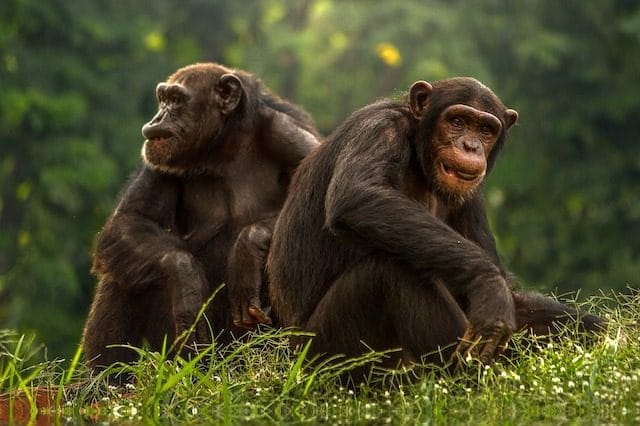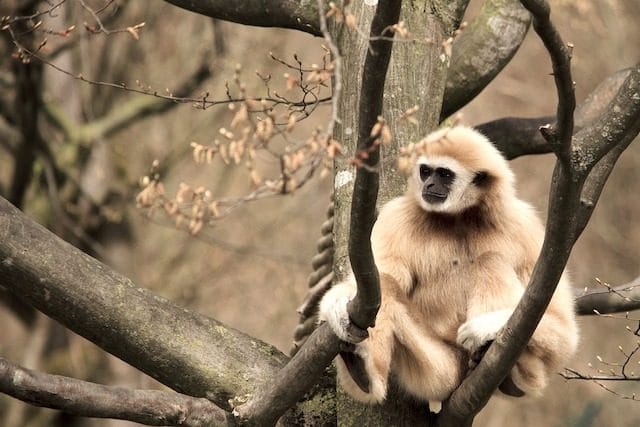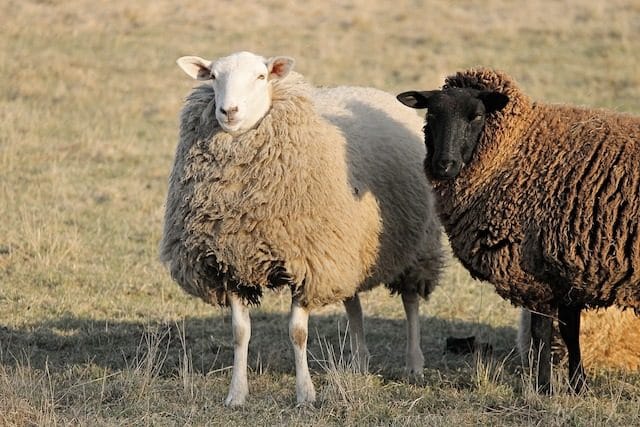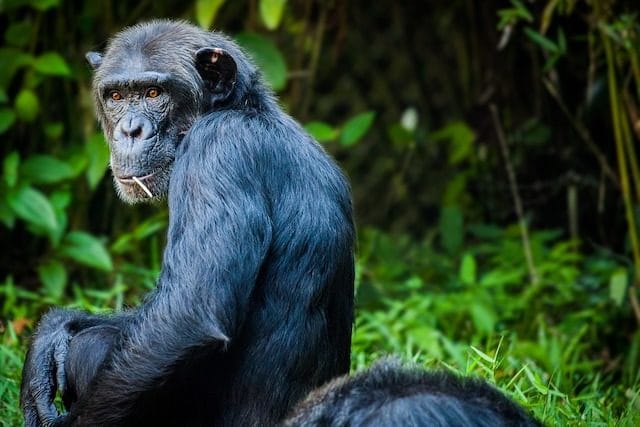Living in a world that’s so detached from nature, we often forget just how connected to it we really are. Many people living in huge cities around the world have never left their urban environments, and as a result, the natural world seems to them as foreign a concept as outer space is for most of us – we know it’s out there, but we tend to think about it more like something out of the realm of sci-fi. Nevertheless, nature is a part of us whether we feel the connection or not, and the many animals that inhabit this world right alongside us are nothing more than our evolutionary cousins – we’re all part of the same big ‘happy’ family. And like with every family, there are some traits that many of us share. It’s time for a long overdue ‘family reunion’ and see just how ‘related and alike’ we all really are.
10. The Ape Connection

Okay, let’s start off this list by getting the obvious out of the way. As most of us know, apes are our closest relatives in the entire animal kingdom. Apes are a branch of tailless anthropoid primates found in Africa and South East Asia. They can further be divided into the so-called great apes such as the orangutans, gorillas, chimpanzee, bonobos, and humans – and the lesser apes like siamangs and gibbons. Our closest cousins here are the chimpanzee, with which we share somewhere between 98.6 and 99 percent of our DNA. Now, if you think this is too much of a similarity, please remember that we also share around 60% of our genes with bananas and chickens – so, yeah. Next on the list are bonobos, which share a 99.6% similarity with chimps, making them, in turn, our second closest relatives.
When it comes to gorillas, we’re almost 98% identical, and are, in fact, more closely related with them than they are with chimps. Estimates indicate that our common ancestor lived some 10 million years ago, at which point humans and gorillas went on their separate ways. DNA analysis has also shown that some genes connected to heart disease and dementia are found in both humans and gorillas, but we are the only ones affected by them. A little further down the line and we have the orangutan with a 97% genetic similarity.
9. The Emotional Bonobos

Now, this list wouldn’t be any fun if all we talked about was percentages, so let’s instead talk about some relatable similarities between humans and other animals. Did you know that, for instance, bonobos regulate their emotions in the same way as humans do? In fact, bonobos are considered to be the most emotional of the great apes – with the exception of humans. A study published in 2013 has revealed that the framework on which we humans build our own social and emotional lives as children is also used by bonobos. Researchers observed that certain bonobos, which quickly got over their own personal upheaval – like losing a fight, for instance – are also the ones to show the most empathy. Those same bonobos are the ones that are first to comfort others in distress either by kissing, embracing, or touching them.
The science team said that “if the way bonobos handle their own emotions predicts how they react to those of others, this hints at emotion regulation, such as the ability to temper strong emotions and avoid over-arousal. In children, emotion regulation is crucial for healthy social development. Socially competent children keep the ups and downs of their emotions within bounds. A stable parent-child bond is essential for this, which is why human orphans typically have trouble managing their emotions.” The team also mentioned the fact that this emotion-regulation evolutionary trait was originally possessed by our common ancestor that lived roughly 6 million years ago, before the two species broke apart. “By measuring the expression of distress and arousal in great apes, and how they cope, we were able to confirm that efficient emotion regulation is an essential part of empathy. Empathy allows great apes and humans to absorb the distress of others without getting overly distressed themselves,” they went on to say.
8. Gibbon Communication Skills

Complex communication is something that sets us apart from all the other animals on Earth. But that difference in complexity is not as wide as we initially believed. As a matter of fact, another group of researchers has identified 26 sounds made by white-handed gibbons that can almost be described as words. These are the type of sounds that the first humans might have used to communicate with each other more than 1.8 million years ago, according to the research team. During their analysis of the gibbons, the scientists have come to realize that some of the sounds serve as a warning against certain types of predators, as well as to give additional information, such as whether the predator is moving or stationary, or how far away it is.
Particular sounds, on the other hand, are used to educate younger gibbons, as well as other members of the group. In a more intimate setting, these gibbons were also observed while conveying their message in a softer tone than usual. In one instance, a father gibbon was observed quietly disciplining his daughter during play. The research team believes that he was trying to moderate his daughter’s aggression – similar to how human parents talk to their rebellious toddlers.
7. Japanese Tits and the ABC-D call
While on the topic of complex speech, Toshitaka Suzuki and his team of scientists have long studied Japanese tits. Minds out of the gutter, folks. The Japanese tit is a species of bird – yes, a bird – closely related to the North American Chickadee, and which has been observed while using compositional syntax in its communication with others of its kind. Up until this particular study came out in 2016, no animal species was known to have this ability, other than humans. A compositional syntax refers to a string of words or phrases that, when put together, create a compound message that contains a reflection of what those parts individually mean. If, for instance, we were to take the phrases “Be careful, it’s dangerous” and “Come toward me” individually, each has its own separate meaning. But if we were to combine them and form something like “Come toward me, but be careful, it’s dangerous,” the phrase takes on a new meaning while still reflecting on the original messages. This is a compositional syntax, and something previously believed to be unique to humans.
But Suzuki has been closely studying tits for over a decade now, and realized that not only do they create such complex speech patterns regularly, but that the order in which those sounds are presented is equally as important. In nature, these birds usually warn each other to look out for potential predators. The research team has named this song as the “ABC” call. This sound is usually followed by another, which the scientists named the “D” call, and which is used by these birds to invite each other to their location. When the ABC-D call is heard, Japanese tits perform both actions. But if that song is reversed and plays like D-ABC, then the birds don’t react as strongly, or as consistently. Researchers speculate that this particular order was chosen naturally over time, since the predator warning part (ABC) is more important than the invitation (D), and the birds that didn’t originally use it were more likely to be eaten or die alone. The research team also speculated that other tit species from around the world use compositional syntax, but the actual rules and order of sounds may be different – a distinct tit language, if you will.
6. Cows Have Regional Accents

Many of us have wondered whether animals speak in different languages, depending on what country they’re from. This would seem highly unlikely, but distance and isolation between groups does play a part in how animal species communicate with each other. This was thoroughly analyzed after some dairy farmers in England noticed that cows had slightly different moos, depending on which herd they originally came from. John Wells, professor of phonetics at the University of London, believes that peer pressure is the main reason behind these regional accents. “When we are learning to speak, we adopt a local variety of language spoken by our parents, so the same could be said about the variation in the West Country cow moo,” said Dr Jeanine Treffers-Daller, professor in linguistics at the University of the West of England.
Or as Shane Gero, assistant professor at the Aarhus University in Denmark puts it, “Behavior is what you do. Culture is how you do it.” For over six years, he’s been studying sperm whales in the Caribbean, and noticed that they use a series of clicks, known as ‘codas’, that are unique only to them and not to other sperm whales around the world. Regional accents and dialects have also been observed in Campbell’s monkeys, rock hyraxes, and many bird species.
5. Your Dog is a Master Manipulator

We all have that friend, or at the very least, know of a friend of a friend who craves so much attention from everyone that they’ll do and say almost anything to get it. Well, as it turns out, man’s best friend does this too – to a certain extent, of course. In a scientific paper published in 2017, psychologists have concluded that dogs do certain facial expressions in order to get sympathy and attention from their human companions. These particular facial expressions were shown to not be influenced by the presence of food, or any other stimuli, and are not something that dogs do to interact with each other. In other words, dogs make these ‘faces’ only in the presence of humans, and with the sole purpose of getting their attention.
Believed to be a trait that dogs picked up during their long period of domestication, the “puppy dog eyes” and “tongue out” looks are prime examples of human-canine communication. A relaxed and open mouth with the tongue showing is a means for your dog to tell you that he’s paying attention. The true meaning behind the “puppy eyes” look, on the other hand, is harder to identify. Scientists speculate that this facial pose triggers the sense of empathy in humans, who think their dog is sad for some reason. Or it could be that it makes their eyes look bigger – and people are generally more attracted to big eyes. Humans also innately respond to certain ostensive facial movements, such as a raised eyebrow, and ‘puppy dog eyes’ cause that reaction in us. Now, whether dogs have a deeper understanding of the human mental state when they make these faces or they’re simply gestures hard-wired into their behavior is something almost impossible to ascertain. But one thing is certain, though – “puppy eyes” work; your dog knows it, and he’s not ashamed to use it to get your love and attention.
4. Some Dolphins Get High Regularly

It might come as a surprise to many, but humans aren’t the only creatures on this Earth to deliberately abuse certain substances. Some dolphins were observed in the wild while passing a Pufferfish between them for up to 30 minutes at a time. These Pufferfish release a potent defensive chemical when threatened. In small enough does, this toxin can have trance-inducing qualities and some dolphins know it. But unlike treating the Pufferfish like ordinary prey, the dolphins carefully and deliberately handle it in such a way that’s indicative of the fact that they know what they’re doing, and it’s not the first time they’re doing it.
Dolphins aren’t the only animals to abuse certain substances, either. It’s a well-known fact that horses sometimes eat certain hallucinogenic weeds, bighorn sheep indulge on narcotic lichen, elephants get drunk on overripe fruit, reindeer occasionally try magic mushrooms, and even bees get drunk now and then. Capuchin monkeys from South America, as well as lemurs from Madagascar, were also seen sometimes gathering in large numbers and passing certain toxic insects around – similar to the dolphins. Monkeys in general have been observed to have a special preference for sugar-rich and ethanol-containing fruit, leading some scientists to speculate that this is the genetic origin of our own preference for alcohol.
3. Sheep Are Often Gay

Contrary to popular belief, many species within the animal kingdom exhibit some sort of homosexual behavior. The most openly gay seem to be Japanese macaques. In some populations, girl on girl action is not only common, but appears to be the norm. What’s more, these encounters seem to be quite intimate. During one such sexual act, macaques regularly look into each other’s eyes – something which they rarely do in other circumstances. Two female macaques can pair up for periods of up to a week, during which time they have sex hundreds of times, but also stay close together, sleeping and grooming one another, and defending themselves from potential rivals. Researchers have also noticed that female macaques use a greater number of sexual positions than males do.
Bonobos are another species of primate that is sometimes described as “over-sexed.” They engage in this particular activity so much that several biologists have started naming the act itself as the “bonobo handshake.” And these bonobos seem to not really care if it’s males or females they’re doing it with. Laysan albatrosses, on the other hand, mate for life – but there are many cases of two females pairing up. Even fruit flies and other insects are known to mate with members of the same sex on occasion.
But the fact of the matter is that none of these animals are strictly gay, and can be better described as bisexual. From an evolutionary and behavioral standpoint, most of these cases can be explained in one way or another. Nevertheless, there is a species out there, besides humans, that has been observed to exhibit a same-sex preference for life, regardless of whether there are potential partners of the opposite sex around, or not: the domestic sheep. In an average flock, roughly 8% of all males prefer other males. In a study performed back in 1994, scientists came to realize that these males had slightly different brains than others – in that their hypothalamus was slightly smaller than in straight males. The hypothalamus is in charge of sex hormones, and it’s a mutation that was also observed in gay men.
Some argue that, if this is the case, the gene that is making the hypothalamus smaller should have already died out since the males who have it don’t actually reproduce. But other researchers have suggested that this particular gene that makes some males gay might also make females who carry it more fertile or sexually active. In other words, gay rams may have sisters with the same gene that end up having more lambs overall – thus balancing him out and keeping that particular gene alive.
2. Religious Chimps

Some biologists studying chimpanzees in West Africa have filmed several of them flinging stones against particular trees, or piling rocks inside certain tree hollows. This behavior seems to serve no practical purpose, making some scientists see a similarity between these chimp-made rock piles and stone cairns made by humans throughout early history. “This represents the first record of repeated observations of individual chimpanzees exhibiting stone tool use for a purpose other than extractive foraging at what appear to be targeted trees,” the researchers said in their paper. “The ritualized behavioral display and collection of artifacts at particular locations observed in chimpanzee accumulative stone throwing may have implications for the inferences that can be drawn from archaeological stone assemblages and the origins of ritual sites.”
While some scientists believe that this may be a primitive form of ritual behavior, others think that there might be something else at play. They say that these chimps throw rocks against trees as a means of making their presence known over long distances. The rock piles, on the other hand, serve as landmarks to help them get around. “Marking pathways and territories with signposts such as piles of rocks is an important step in human history,” said one of the researchers. “Figuring out where chimps’ territories are in relation to rock throwing sites could give us insights into whether this is the case here.” Whatever the case may be, everyone agrees that further study is needed before making an official statement on the matter. Interestingly enough, other chimps have also been observed while performing some sort of “ritualized” dance during heavy rainfalls, in front of waterfalls, or moving in slow motion in front of bush fires. All of these seem to imply that chimps have a deeper understanding of extraordinary natural phenomena and that they might be paying some sort of ‘respect’ towards them.
1. Stone Age Primates
https://www.youtube.com/watch?v=GC25X6d2dds
We tend to think of the Stone Age, or any other such ‘age’, as something strictly human. This particular period in our evolution lasted for more than 3.4 million years and ended with the advent of metalworking sometime between 8700 and 2000 BC, depending on the region. Some people, like the isolated North Sentinel Islanders, are still living in the Stone Age. In any case, many animal species such as mammals, birds, fish, and even insects use various objects from their environment as tools to help them acquire food. Gorillas, orangutans, and even crows have been seen using twigs or sticks to get food, but almost never stone tools. What’s more, this behavior seems to be limited to only one individual, and is never passed down through the generations, or used in a different setting. Only three animal species have been observed to use stone tools: some chimps in West Africa, bearded capuchins in Brazil, and the long-tailed macaques in Thailand.
Archeological evidence points to the fact that some of the chimps living in West Africa entered their respective Stone Age at least as early as 4,300 years ago. A similar archeological investigation in Brazil’s Serra da Capivara National Park has shown that the capuchins living there have been in the Stone Age since the 13th century. Thailand’s macaques are the last to join the ‘Stone Age club’, with evidence showing them using stone tools over the past 65 years. What’s particularly interesting about these macaques is that they were able to transfer this knowledge from one environment to another. They first learned to use stones to crack open shells while on the beach. Over the past 13 years, however, oil palms have been introduced to Thailand. Though they never saw these trees before, the macaques were able to transfer their knowledge from the beach and into the palm oil plantations, where they regularly open nuts with stones. What’s particularly fascinating here is that it only took them 13 years to do so. It’s thus, sufficed to say, that these discoveries have laid the basis for an entirely new field of science known as primate archaeology.
